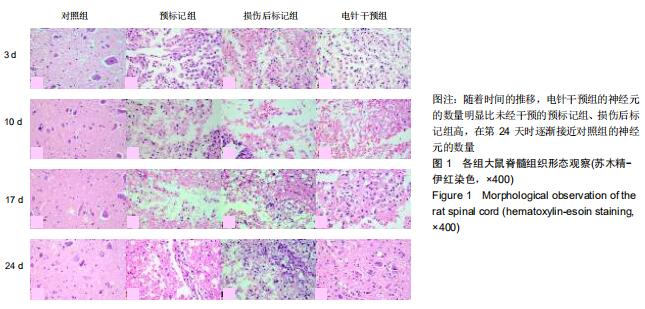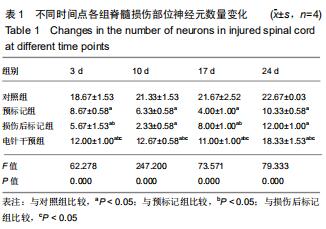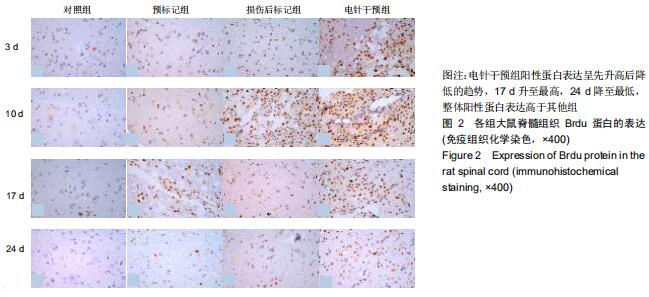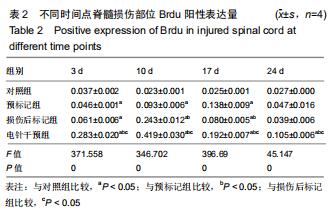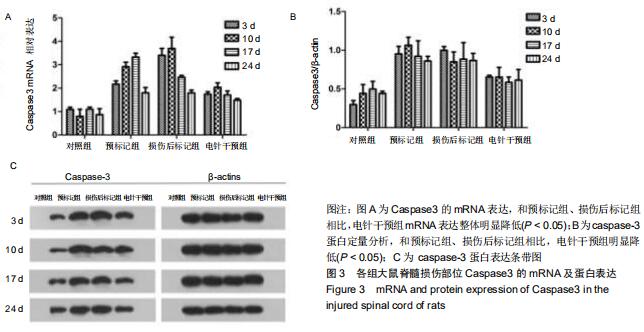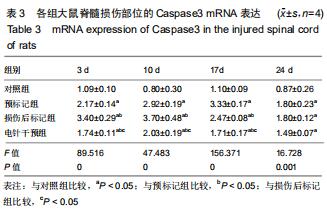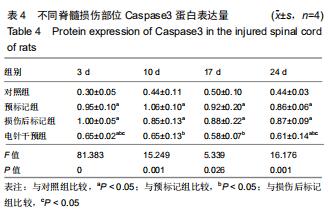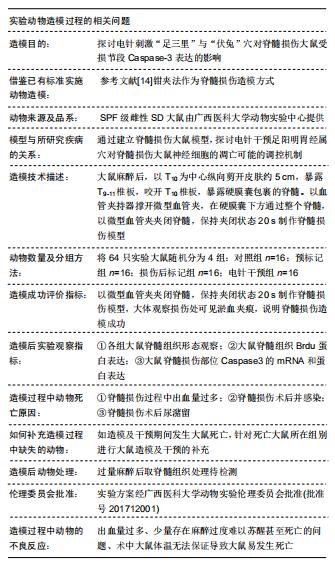|
[1] 陈星月,陈栋,陈春慧,等.中国创伤性脊髓损伤流行病学和疾病经济负担的系统评价[J].中国循证医学杂志,2018,18(2):143-150.
[2] SCHWAB JM, MAAS A, HSIEH J, et al. Raising awareness for spinal cord injury research. Lancet Neurol. 2018,17(7):581-582.
[3] BRAGGE P, GUY S, BOULET M, et al. A systematic review of the content and quality of clinical practice guidelines for management of the neurogenic bladder following spinal cord injury.Spinal Cord. 2019;57(7):540-549.
[4] REN XD,WAN CX, NIU YL. Overexpression of lncRNA TCTN2 protects neurons from apoptosis by enhancing cell autophagy in spinal cord injury.FEBS Open Bio.2019;9(7): 1223-1231.
[5] KAWABATA H, SETOGUCHI T, YONE K, et al. High mobility group box 1 is upregulated after spinal cord injury and is associated with neuronal cell apoptosis. Spine (Phila Pa 1976).2010;35(11):1109-1115.
[6] ZHAO D, ZHANG M, YUAN H, et al. Ginsenoside Rb1 protects against spinal cord ischemia-reperfusion injury in rats by downregulating the Bax/Bcl-2 ratio and caspase-3 and p-Ask-1 levels.Exp Mol Pathol.2018;105(3): 229-235.
[7] YUAN B, PAN S, ZHANG WW. Effects of gangliosides on expressions of caspase-3 and NGF in rats with acute spinal cord injury.Eur Rev Med Pharmacol Sci.2017;21(24): 5843-5849.
[8] GASHMARDI N, HOSSEINI SE, MEHRABANI D, et al. Impacts of Bone Marrow Stem Cells on Caspase-3 Levels after Spinal Cord Injury in Mice.Iran J Med Sci.2017;42(6): 593-598.
[9] LIN HS, JI ZS, ZHENG LH, et al.Effect of methylprednisolone on the activities of caspase-3,-6,-8 and -9 in rabbits with acute spinal cord injury. Exp Ther Med.2012;4(1):49-54.
[10] CITRON BA, ARNOLD PM, HAYNES NG, et al. Neuroprotective effects of caspase-3 inhibition on functional recovery and tissue sparing after acute spinal cord injury.Spine (Phila Pa 1976). 2008;33(21):2269-2277.
[11] DASARI VR,SPOMAR DG,CADY C,et al.Mesenchymal stem cells from rat bone marrow downregulate caspase-3-mediated apoptotic pathway after spinal cord injury in rats.Neurochem Res.2007;32(12):2080-2093.
[12] 杨扬,徐昊禹,丁英,等.两种督脉电针对大鼠脊髓受损伤神经元存活的影响[J].解剖学研究,2018,40(1):2-5+84.
[13] FAN Q, CAVUS O, XIONG L, et al. Spinal Cord Injury: How Could Acupuncture Help.J Acupunct Meridian Stud.2018; 11(4):124-132.
[14] 魏卫兵,周祥兴,周宾宾,等.构建不同脊髓损伤节段模型大鼠下肢功能恢复的评价[J].中国组织工程研究,2019,23(7):1073-1077.
[15] 余曙光,徐斌.实验针灸学[M].北京:人民卫生出版社,2012:277.
[16] SOSLOW RA, DANNENBERG AJ, RUSH D, et al. COX-2 is expressed in human pulmonary, colonic, and mammary tumors. Cancer.2000;89(12):2637-2645.
[17] 赵吉平,李瑛.针灸学[M].3版.北京:人民卫生出版社,2016:12.
[18] 韩玉,尹洪娜,郭玉怀,等.脊髓损伤的临床治疗进展[J].中华中医药学刊,2019,37(5):1115-1119.
[19] ZHANG Y, ZHANG WX, ZHANG YJ, et al. Melatonin for the treatment of spinal cord injury. Neural Regen Res. 2018; 13(10):1685-1692.
[20] 林香均.“针灸即安慰剂”之缘由与剖析[D].北京:北京中医药大学,2016.
[21] JIANG YQ, ZAAIMI B, MARTIN JH. Competition with Primary Sensory Afferents Drives Remodeling of Corticospinal Axons in Mature Spinal Motor Circuits.J Neurosci.2016;36(1):193-203.
[22] WILLAND MP, HOLMES M, BAIN JR, et al.Sensory nerve cross- anastomosis and electrical muscle stimulation synergistically enhance functional recovery of chronically denervated muscle. Plast Reconstr Surg.2014;134(5):736e-745e.
[23] ZHANG C, RONG W, ZHANG GH, et al. Early electrical field stimulation prevents the loss of spinal cord anterior horn motoneurons and muscle atrophy following spinal cord injury. Neural Regen Res. 2018;13(5):869-876.
[24] 吕威,李冰,景泉凯,等.电针“大椎”“命门”对脊髓损伤大鼠神经元细胞凋亡及JNK信号通路相关蛋白表达的影响[J].针刺研究, 2017,42(1):14-19.
[25] 李晓宁,吴磊,迟蕾,等.不同治疗周期夹脊电针对急性脊髓损伤大鼠运动功能及细胞凋亡的影响[J].针刺研究,2016,41(6):492-496.
[26] GENG X, SUN T, LI JH, et al.Electroacupuncture in the repair of spinal cord injury: inhibiting the Notch signaling pathway and promoting neural stem cell proliferation. Neural Regen Res.2015;10(3):394-403.
[27] WANG J, ZHENG Q, ZHAO M, et al. Neurocyte apoptosis and expressions of caspase-3 and Fas after spinal cord injury and their implication in rats.J Huazhong Univ Sci Technolog Med Sci.2006;26(6):709-712.
[28] BRECKENRIDGE DG, KANG BH, KOKEL D, et al. Caenorhabditis elegans drp-1 and fis-2 regulate distinct cell-death execution pathways downstream of ced-3 and independent of ced-9. Mol Cell.2008; 31(4):586-597.
[29] FAUBEL S,EDELSTEIN CL. Caspases as drug targets in ischemic organ injury. Curr Drug Targets Immune Endocr Metabol Disord.2005;5(3):269-287.
[30] SPRINGER JE, AZBILL RD, KNAPP PE. Activation of the caspase-3 apoptotic cascade in traumatic spinal cord injury.Nat Med.1999;5(8):943-946.
[31] 张志英,余安胜,严振国.电针对脊髓损伤早期caspase-3 mRNA及蛋白表达的影响[J].解剖学杂志,2002.25(6):548-552.
|

